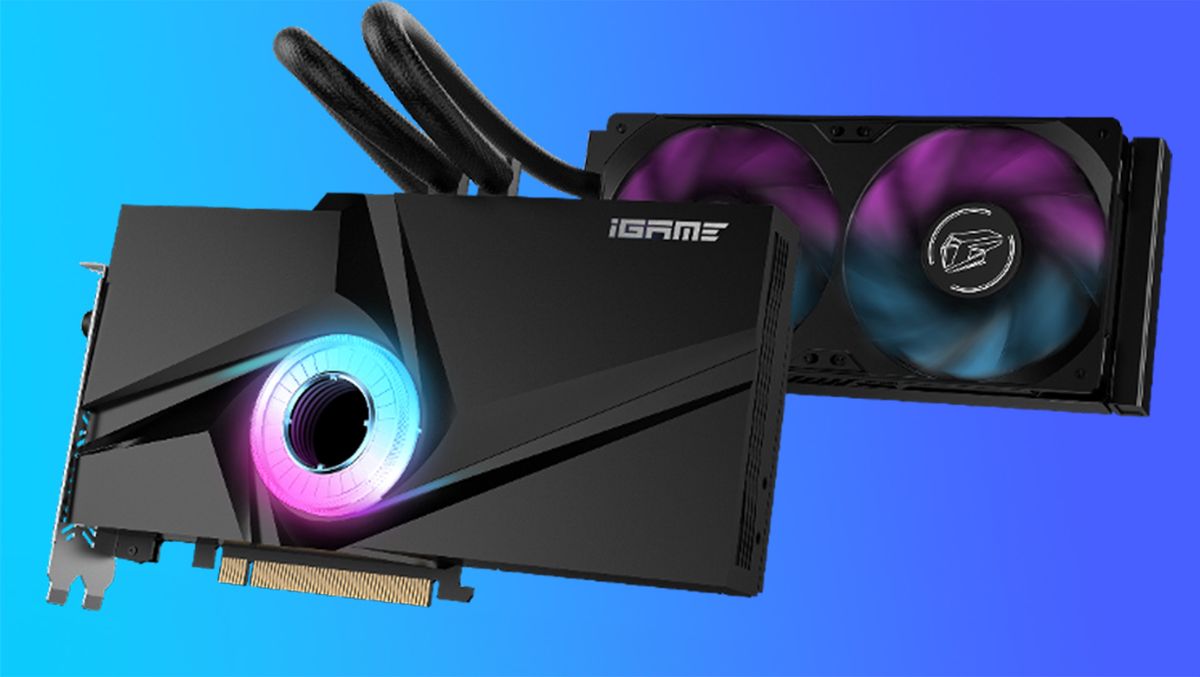After a delay of a few months, Nvidia has finally released the RTX 3090 Ti—the new ultra-enthusiast class graphics card from the green team. Described by its creators as “a monster of a GPU”, we can attest to that after seeing what third-party manufacturers have stuck on the full GA102 GPU within to keep it cool.
The RTX 3090 Ti is similar to the GeForce RTX 3090 in many ways, but it does offer a 2.4% increase in CUDA Cores: from 10,496 to 10,752. That brings with it another two RT Cores and eight more Tensor Cores, for a slight increase in ray tracing and machine learning performance.
Instead you’ll find the majority of the performance of this card comes from faster clock speeds. The RTX 3090 Ti runs at a base of 1,560MHz and will boost to 1,860MHz as standard. Chunkier third-party models, such as the Colorful iGame Neptune—a GPU with its own liquid cooling loop attached—will boost a further 45MHz.
We’ve been playing with the Asus TUF RTX 3090 Ti OC card, and that’s rated, in OC Mode, to run at 1,950MHz. Though it’s actually been running faster than that in our benchmarking—hitting an average of 1,990MHz in our 4K Metro Exodus torture test. And at 1080p the Asus card will run above the 2GHz mark on average.
The 24GB of GDDR6X memory on the RTX 3090 Ti will also run at 21Gbps, a step-up from the 19.5Gbps memory on the RTX 3090.
Though these speed boosts are thirsty work, and every RTX 3090 Ti model we’ve heard of from Colorful creeps up to a whopping 480W. Though models from other manufacturers may sit at 450W. That’s a serious step-up from the RTX 3090 at 350W, and will commonly require an 850W PSU in order to run, though Asus is suggesting a 1,000W PSU as a recommended spec.
The higher-end OC models can crank up to 510W at times, which really makes for a stunningly power-hungry card. As a result, larger coolers, even liquid coolers, are commonplace across the RTX 3090 Ti range we’ve seen so far. Our test sample has been topping out at 492W, which is still pretty thirsty.
Are the performance gains worth it for all that extra heat and material? I mean, it would be quite absurd making a 29–46% leap in power draw without serious return, right? With our RTX 3090 Ti TUF, however, the returns certainly aren’t there in gaming terms; we’ve been seeing the performance delta over the RTX 3090 Founders Edition to be just 5 – 13% at best.
And remember, that’s with an overclocked version.
This is why Nvidia has been so keen to talk up its professional uses for its new card… despite still positioning it as a GeForce card and not as a Titan. Throw it at some Blender rendering and it will still fly compared to other RTX 30-series cards, but in gaming it really is a question of slight returns.
Swipe to scroll horizontally
| Header Cell – Column 0 | RTX 3090 Ti | RTX 3090 |
|---|---|---|
| GPU | GA102-350 | GA102-300 |
| Architecture | Ampere | Ampere |
| CUDA Cores | 10,752 | 10,496 |
| Tensor Cores | 336 | 328 |
| RT Cores | 84 | 82 |
| Base clock | 1,560 | 1,395 |
| Boost clock | 1,860 | 1,695 |
| Memory capacity | 24GB | 24GB |
| Memory speed | 21Gbps | 19.5Gbps |
| TDP | 450W | 350W |
Your next upgrade
Best CPU for gaming: The top chips from Intel and AMD
Best gaming motherboard: The right boards
Best graphics card: Your perfect pixel-pusher awaits
Best SSD for gaming: Get into the game ahead of the rest
In the UK, the RTX 3090 Ti is going for around £1,879, with high-end, liquid-cooled versions going for around £2,050 if not more. That roughly aligns with the $1,999 price over in the US that was previously rumoured, though you will find the larger models selling upwards of that.
At least it doesn’t appear to be priced anywhere close to the $4,000 price tag once posited by early listings, though those price tags really were unbelievable. That being said, we do know that the pricing from at least one vendor has dropped some $800 in the past couple of weeks, so the launch price for third-party cards would have been far higher once upon a time.
Still, it’s a lot of money for an RTX 30-series card in the same year that we’re expecting Nvidia (and AMD) to release a new GPU generation. Of course, that’s all subject to change, but this may well be one last high-performance, high-power hurrah for Ampere.


